Skin
Much as I love to produce epic panoramas of sweeping vistas it’s often the people who best capture the flavour of a place. Ideally I aim to return from a trip with a comprehensive collection of images ranging from landscapes to street scenes, portraits and details, which will form a photo essay on my website and support each other as a set. Each image is stronger as a part of that set than it is on its own, and the portraits and candid images of people in their own environments are a vital element.
Every photographer has a style and unique way of working. As I seem to spend half my life stood beside my tripod waiting for the perfect light for my landscape work, I adopt a completely opposite approach with my people shots: opportunistic, spontaneous and impulsive. I like to react to what’s going on around me rather than to manipulate it; posed portraits of people staring balefully at the camera are not for me. It’s all about observation, interaction with the subjects, speed and making the most of fleeting opportunities.
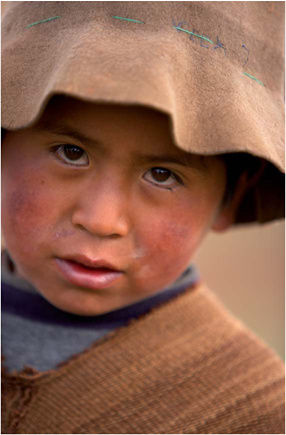
Farm boy, near Chincerro, Peru
The composition of a portrait has to happen almost instantaneously, but as with all images the arrangement of the shapes within the frame and the absence of background clutter are crucial factors. Usually for portraits I work with the lens wide open at f/2.8 to drop the background out of focus, but I have to be so accurate with the focusing at that aperture and range. Usually, the eyes are the focusing point. The camera’s auto-focus does a good job normally, but I have to be aware of what it is focusing on and be ready to override it quickly if necessary.
• Canon EOS-1Ds MKII, 70–200mm lens

Quechua woman, Chincerro market, near Cusco, Peru
Markets are always a good hunting ground for people pictures. Here in Chincherro, above the Sacred Valley of the Incas, this Quechua woman is possibly a direct descendant of the Incas. The colours and vibrant cultures of Peru are unique; there aren’t many places left in the world where most people wear native dress.
• Canon EOS-1Ds MKII, 24–70mm lens
“It’s all about observation, interaction with the subjects, speed and making the most of fleeting opportunities”

Old ladies in a rickshaw, Hanoi, Vietnam
You take your life into your hands crossing the street in Hanoi. There never is a break in the stream of bleeping motorbikes and bicycles. You just have to take a leap of faith and step out into the flow. I’m standing watching the rush of humanity pass under a heavy leaden grey sky. I’ve been out all day shooting the rich pageant of Vietnamese street life. A rickshaw approaches, I dial in 1/8sec with shutter priority exposure, pan and shoot, fleetingly aware of piercing stares boring into my lens as they pass. It’s a moment that’s gone before I can barely register it, a decisive moment only to be recognized on the contact sheet a month later.
• Nikon F5, 20–35mm lens
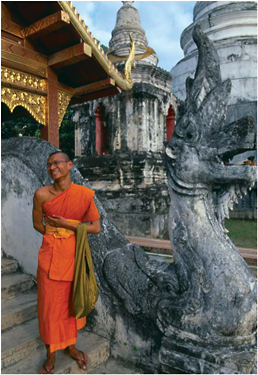
Do I always ask permission? No, for candid shots it doesn’t work, the moment has passed, but sometimes it would be rude not to. People often refuse, many a time I’ve trudged away from an absolute classic, but what more can I do? Refusals used to be a real setback; I’d brood on them for hours. I’d seldom get back into the groove after a couple of brusque rejections, but I’ve become less sensitive and thicker-skinned over the years. I’ve had fruit thrown at me and dogs set on me, but it’s my job, so I just get on with it. I’m never intrusive with my photography, but this game is all about getting stuck in, making the most of a situation, being up close, in the thick of it; sitting on the fringes with a long lens afraid of upsetting anyone just doesn’t work.

Monk at Wat Phra Singh, Chiang Mai, Thailand
We make a good team, Wendy and I. People often freeze up when the camera is raised, staring woodenly into the lens, body tense; it takes some effort to loosen them up. Here in Wat Phra Singh in Chiang Mai, Wendy is off to my left, chatting to the monk to distract him from the intruding photographer. Then as they continue to talk I move in for a study of his hands clutching his scroll.
• Nikon F5, 17–35mm lens / Nikon F5, 28–70mm lens

Lijiang, Yunnan Province, China
The sun at this altitude beams down with searing clarity. I’m sitting in the square just watching the world go past, soaking up the rays and the atmosphere, feeling good. An old boy sits on the wall next to me; his face is like a historical map of China. The light is too harsh, but I’ve got to try for a shot, what have I got to lose? I gesture, he gestures back, I gesture again; I think it’s game on. With the 70–200mm f/2.8 zoom set at about 135mm I squeeze off a few frames. We start communicating again, despite the total lack of a common language. He’s pointing at my shades on the top of my head, he wants to try them on. I pass them over and raise my camera; compose, focus, expose … he’s loving it. There’s a clutch of Chinese tourists now taking pictures of the two of us, the quintessential face of China wearing Oakleys and me, the westerner with a big lens. He then jumps up and makes as if to run off with my sunglasses with me in mock pursuit, and the whole square erupts with laughter. It’s just one of those rare magical travel moments that leave a warm feeling. I head for my lunchtime noodles on a high.
• Nikon F5, 70–200mm lens
A sad fact of life nowadays is that people often want money for pictures. Should you pay? It’s a tough question. Generally speaking I’d say no, it just ruins it for everybody else, distorts the local economy and makes the locals into photographic hustlers. In the Plaza de Armas in Havana there’s a bloke with a wrinkled face, fulsome grey beard, Guevara beret and cigar who makes a living charging tourists $5 per picture. When I was judging a travel photography competition recently his mug popped up numerous times, and he’s currently staring out of the window of the local bookshop from the cover of a Cuban travel guide. I must admit I shot him too, but as I walked away from that encounter I felt a fraud.
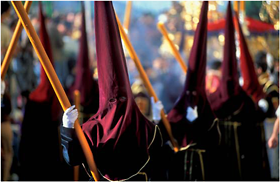

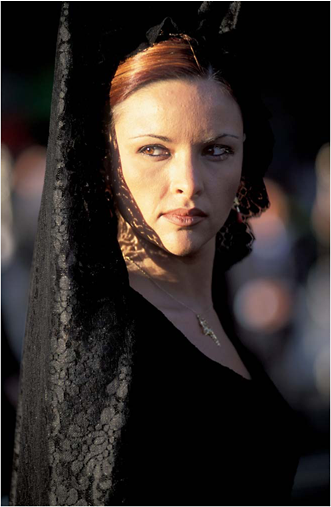
Semana Santa fiesta, Málaga, Spain
At Easter throughout Spain the Semana Santa processions parade through the streets in a display of religious devotion. I’m in Málaga pushing my way through the crowds, trying to get an angle on it all. The blokes in the tall purple hats and black robes inevitably draw my attention. I didn’t expect the Spanish Inquisition. I’m treading on people’s toes as I try to get the best backdrop as the procession marches past; the crowds make it difficult and there’s so much going on. A choirboy is momentarily backlit, looking suitably devoted. The procession halts and I spot a black-clad widow with features so Spanish it’s outrageous. I move around to shoot her cross lit by the evening sun; it’s a bit harsh but what can I do? Not photograph her? She knows I’m focused on her but she loves it, striking numerous noble poses before they move on.
• Nikon F5, 70–200mm lens
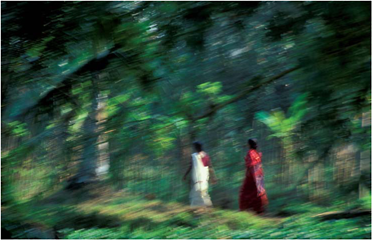
Backwater scenes, Kerala, India
Five days spent being paddled along the backwaters of Kerala on a houseboat have given us a unique viewpoint on rural India. Our merry crew consists of two boatmen to pole us along and a cook to feed us unfeasible amounts of coconut curry. We just sit and watch India drift past. It’s not a great trip for the fitness, this one, but we’re certainly well off the beaten track and there’s plenty of time for contemplation and photographic experimentation. A couple of women in their bright saris are walking along the path amongst the lush tropical vegetation and I make a slow panning exposure of them, blurring the motion to an outrageous extent. As evening settles a farmer tends his flock of ducks on the river: how does he possibly remain balanced in such a tiny craft?
• Nikon F5, 80–200mm lens / Nikon F5, 300mm lens
My shot was undoubtedly no different from countless others, a worthless reinforcement of a stereotyped cliché. I have to believe that what I’m doing is unique; otherwise it’s just a record. Of course, there are times when someone has genuinely put themselves out for you and in those cases some sort of donation is reasonable. Usually the further you are off the beaten track the less of an issue this is. I’ve had people thanking me for taking their picture in the backwaters of Kerala, and on the Tibetan plateau the kids were almost fighting to be the subject of my lens. But where legions of camera-clutching packaged tourists predominate, the locals will most likely be seeing dollar signs when a camera is focused.

Kathmandu, Nepal

It’s the last day of the Nepal trip and I’ve taken a walk just to see what I come across. There are a couple of sadhus hanging out in Durbar Square, holy men looking like something from biblical times. Today, with no specific location in mind I’m ambling with a body and just two lenses, a 28–70mm and 70–200mm f/2.8 zoom. I kneel next to one of the sadhus and we have a halting conversation – my Hindi is lousy. I’m buying time and trying to develop some sort of rapport while composing the shot, assessing the light and dialling in my camera settings without breaking eye contact. When an opportunity presents itself there’s no time for changing lenses or messing around with camera controls, so it’s important to be totally familiar with your kit. If it’s a classic medium telephoto portrait such as this I’ll almost always be working with the lens wide open at f/2.8 so the minimal depth of field drops the background out of focus. Even so, annoying details in the background can ruin a shot. I point to my camera, raise my eyebrows … Yes! I squat down, move around to isolate his face against a dark background, raise the camera, lightly depress the shutter, hold the focus on his right eye as I recompose, shoot. Exposure OK? No time to bracket: at aperture priority AE with +0.3 compensation dialled in to compensate for the brightness of his beard and face paint, I’m trusting to long experience of my camera’s metering to get it right. The light of late afternoon is strong and directional; ideally I’d like it a bit softer, but this is the real world. Five frames exposed, I move around for a different shot, but he’s had enough so I stop. Namaste. I back away with a spring in my step.
“When an opportunity presents itself there’s no time for changing lenses or messing around with camera controls, so it’s important to be totally familiar with your kit”
